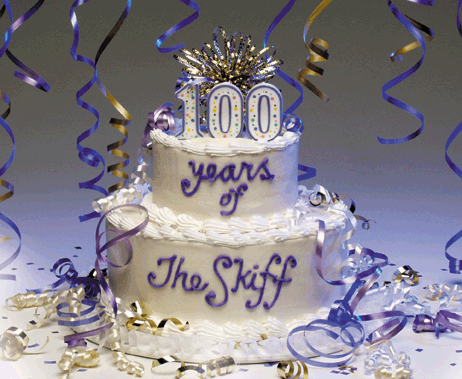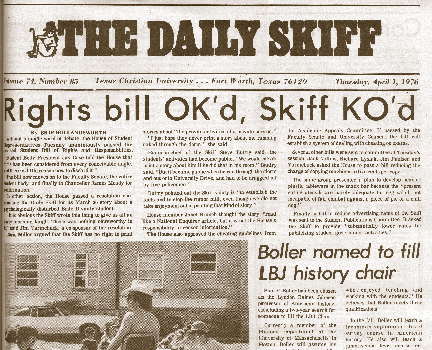|

100 years
of the Skiff
Gone are the ads for shaving parlors,
15-cent baths and $8 suits, but the value of good reporting has remained
constant.
By Nancy Bartosek

Ed McKinney
just wanted to get back into school in 1902. But money was a problem,
so the enterprising young football player contacted some local businesses,
rustled up support from a former classmate-turned-professor named Colby
Hall and started a school newspaper.
McKinney's
goals weren't terribly altruistic, and though he did provide a service
to 300 fellow students, the point was to pay his way through school. And
thus, The Skiff, the boat that McKinney would board to "sail the
financial waters" of education, was born.
 His
four-page-per-issue enterprise celebrates 100 years of journalistic excellence
this year. Nearly 2,000 students have contributed to its content and in
the process earned more prestigious awards than can be counted. Hundreds
have gone on to illustrious and productive careers in the news industry. His
four-page-per-issue enterprise celebrates 100 years of journalistic excellence
this year. Nearly 2,000 students have contributed to its content and in
the process earned more prestigious awards than can be counted. Hundreds
have gone on to illustrious and productive careers in the news industry.
But back
in 1902 covering the news was apparently incidental. The Skiff's
original mission sounded more like a PR pitch than solid journalistic
intent: ". . . reviving college sports, promoting clean athletics,
encouraging healthy rivalry between the [literary] societies and furnishing
the local news to the student body and the friends of the school abroad."
McKinney's
first goal, however, was realized -- not only did the school trade tuition,
room and board for his paper's promotion of the university, McKinney pocketed
any profit garnered from advertising and the 50-cent annual subscriptions.
Early issues
reflected the publication's mission, with flowery discourses about the
activities of the various literary societies and lots of rah-rah for the
football team. The ads were for men's clothing, other schools, entertainment
and local shops and mercantiles -- as well as what appears to have been an
early version of the classifieds, with notes about who visited whom, items
for sale, more calls for support for the football team and personal commentary
about whatever someone felt like saying.
Although
the content continued to reflect the original goals for some years, internal
change came quickly. Three years into the endeavor, a new editor took
over and a business manager was hired -- though the paper remained a private
enterprise until 1928. Still, the school maintained some control, with
a Committee of Publications choosing the business manager and the student
body electing the editor, which was then approved by the publications
committee.
A change
in the masthead followed the early change in leadership, and McKinney's
motto "Rowing, not Drifting," was replaced by a sentiment that would ensure
a long and distinguished future: "A Weekly Newspaper: Published under
the Auspices of the Student Body and Alumni of Texas Christian University."
The editors
continued covering school news and events while maintaining the paper's
cheerleader mentality for the next two decades.
A major
shift occurred in 1927 when administrators hired J. Willard Ridings to
establish a department of journalism and organize the university's first
public relations program. A graduate of the University of Missouri School
of Journalism, Ridings had a simple departmental goal: produce journalists
who can find jobs in journalism when they graduate. The paper would be
a central part of that training.
The Skiff
became an anchor.
 The
paper was published by the department as a "lab" paper where
students would learn journalistic skills firsthand. Housed in a "cubbyhole"
office on the second floor of the Administration Building, the department's
30 students would work in crowded quarters for more than a decade before
moving to the basement of Goode Hall, where they enjoyed the school's
first photo lab. The
paper was published by the department as a "lab" paper where
students would learn journalistic skills firsthand. Housed in a "cubbyhole"
office on the second floor of the Administration Building, the department's
30 students would work in crowded quarters for more than a decade before
moving to the basement of Goode Hall, where they enjoyed the school's
first photo lab.
Ridings lobbied
hard for printing facilities during his time at TCU, believing that all
good journalists needed to have type skills as well. He settled for field
trips to local papers where the students would help edit small-town papers.
Somewhat fittingly, Ridings' last day was spent with the students on one
of these field trips. He died unexpectedly in 1948, nearly three decades
after founding the journalism department.
That year
his son, Paul O. Ridings '38, would return to his alma mater and take
the reins of the department. One of his first accomplishments was to organize
the TCU Journalism Exes Association, a group that still meets annually
at Homecoming and currently lists nearly 1,800 members.
By 1952,
the department and The Skiff had grown significantly. After squeezing
for several years into a temporary structure in an area known as Splinter
City, the paper found a new home in Dan Rogers Hall in 1957, where Ridings'
goal of a printing facility was finally realized.
In 1967
the news-editorial program leapt a big hurdle, becoming the first private
school in Texas to earn accreditation by the American Council on Education
in Journalism.
Along the
way, The Skiff spoke out editorially on issues important to the
students. Following the 1910 fire, the move to Fort Worth was encouraged.
In the '30s, a drive to allow sponsored dances and bridge playing on campus
resulted in rule changes. In the late '40s and early '50s The Skiff
called for a Student Union, which was built later in the decade and is
still in use. The '50s also showed signs of the times with a proliferation
of cigarette ads and glamour-girl shots in the paper.
As times
changed, so did The Skiff. By the '60s the war and civil rights
were debated. The '70s saw stories about plastic greenery, low voter interest
and a pipe bomb that exploded near a fraternity house. A university official
was quoted as responding, "We are not going to search the rooms. I consider
that a Gestapo-type approach to dealing with student discipline."
The '70s
also saw the dawning of the electronic age, as well as the move from a
twice-weekly tabloid paper to a four-times-a-week broadsheet with a new
name -- The TCU Daily Skiff. When the paper and journalism department
moved into their current home in the J.M. Moudy Building in 1982, the
department expanded its offerings to include a graduate degree in media
studies.
Ed McKinney
would be flabbergasted to see what he started way back in 1902. Today
the Skiff office is filled with banks of computers and a blur of
busy reporters, editors, photographers and advertising reps. In fact,
the paper is no longer just paper -- you can read it online.
Next door,
Skiff TV takes news to a new level, producing streaming video stories
that students can watch on computers in their rooms.
Gone are
the ads for shaving parlors, 15-cent baths and $8 suits, but the value
of good reporting has remained constant, as has the purpose expressed
by the editors in 1902 -- "to give the outside world a panoramic view of
our college life."
Three months
into their new venture, the 1902 Skiff staff expressed optimism
that their work would continue by proclaiming: "We believe The Skiff
has grown out of the experimental stage, and we propose from now on, henceforth
and forever, so help us -- with your influence, to make it a permanent feature
of the University."
Well done,
Frogs. Well done.

To comment
about this article, write to tcumagazine@tcu.edu
Top
|



